Whether you’re working on DIY projects, maintaining your car, or simply organizing storage, the right garage lights can make all the difference.
In this ultimate garage lighting guide, we’ll provide a comprehensive overview of the various light fixtures and bulbs available and some other important considerations.
If you’ve been struggling to sift through all the options to find the best lights for your garage, you’ve come to the right place. You’ll learn how many lumens you’ll need in your garage, how to choose the perfect color temperature and CRI, and much more.
Let’s get started.
Planning Your Garage Lights
Before you click the “Buy Now” button, spend a little time thinking about what your ideal garage lighting looks like. There are a lot of options out there.
To help, I’ve narrowed down the decision to these three core factors:
- Garage Purpose: What’s the primary goal for your garage lighting? Do you need task lighting for a workbench or ambient lighting to illuminate your entire garage?
- Space & Layout: The size and layout of your garage determine how many fixtures and what type you’ll need. Larger garages typically require different lighting solutions vs. smaller ones.
- Budget & Energy Efficiency: Consider the upfront cost and how much your lights will cost to operate. For example, my garage is exceptionally bright but uses almost 400 watts every time I turn on the lights. You’ll need to balance up-front costs and potential energy savings when deciding how bright you want your garage.
Types of Garage Lighting Fixtures
Now that we understand what to look for when choosing garage lighting, let’s look at all your options.
Shop Lights
Shop lights are all-in-one light fixtures typically used to illuminate large, open spaces like garages, workshops, and retail stores. They’re designed to provide bright, consistent lighting for tasks that require clear visibility, such as working with tools and machinery.
They have various types of light bulbs (more on that in a later section), but the most common are fluorescent and LED shop lights.

Similar to:
Wraparound lights or dedicated lighting fixtures.
Who Should Install Shop Lights in Their Garage:
Shop lights are perfect for homeowners who need a lot of ambient light to illuminate their entire garage. It’s ideal for those working on automotive repairs, woodworking, metalworking, or other tasks that require precision and clarity. The bright and even lighting from shop lights reduces shadows and helps in reducing eye strain.
Avoid Shop Lights If…
Shop lights are commonly found in cooler color temperatures, meaning the light they give off is more blue-white than yellow. If the color temperature is too high, it can create a harsh environment. Because their light is so intense, shop lights may not be suitable for small spaces or low ceilings. It might overwhelm small areas, creating too much glare and uncomfortable brightness levels.
Costs:
- Initial Cost: Basic LED shop lights are as low as $20-$40. Higher-end models can go up to $100 or more.
- Energy Efficiency: Shop lights, especially when fitted with LED bulbs, are more energy-efficient and consume less power than traditional incandescent lights.
Final Thoughts: Shop lights are a great way to light up your entire garage without breaking the bank. They’re best used for ambient lighting, saving other types of garage lighting for areas where you need more directional light. LED shop lights are energy efficient and offer long-term savings, although they may require a more substantial initial investment.
Triburst (3-panel LED lights) / Upgraded Light Sockets
Triburst (3-panel LED) lights are a unique garage lighting solution that fits a standard light socket. They consist of three adjustable LED panels that can be aimed to direct light in different directions.
Although several companies make a similar product, the original (and most popular) is the Triburst lights from Bell & Howard.
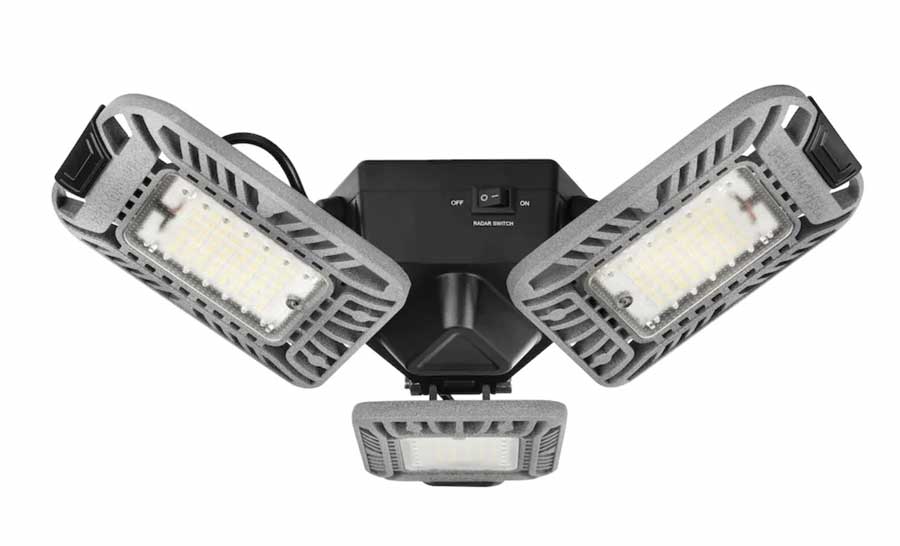
Similar to:
Standard lightbulbs, multi-directional LED lights, or adjustable spotlight fixtures.
Who Should Install Triburst Lights in Their Garage:
This type of light is perfect for homeowners who don’t need a lot of additional light in their garage or need the simplest installation possible. Since they use a standard light socket, Triburst lights eliminate the need for other adapters or fixtures.
Avoid Triburst Lights If…
Avoid Triburst lights if you require a very bright garage or an even amount of light across the entire room. Since they have a cool color temperature, Triburst lights aren’t appropriate for artists or woodworkers who need a soft, ambient glow.
Costs:
- Initial Cost: Typically ranges from $30 to $80 for Triburst lights.
- Energy Efficiency: These LED lights are generally more energy-efficient than traditional lighting options. Dollar-for-dollar, however, you’ll get more lumens with a standard LED shop light than with Triburst lights.
Final Thoughts: Triburst 3-panel LED lights are a terrific choice for homeowners who only need a slight upgrade to their garage lighting. They’re quickly outclassed by nearly every other lighting fixture, however.
Light Fixtures (T5, T8, T12)
While all of these garage lighting options are ‘light fixtures,’ I’m explicitly referring to fixtures that can accommodate replaceable tube lights in this section.
T-bulbs were initially designed as fluorescent tube lights, with the number referring to the size of the bulb. The most common size you’ll find for garage lighting is either T5 or T8.
- T4: 0.5 inch (4/8 inch) diameter, usually 6 to 12 inches long
- T5: 0.625 inch (5/8 inch) diameter, usually 12 to 60 inches long
- T8: 1 inch (8/8 inch) diameter, usually 18 to 96 inches long
- T12: 1.5 inch (12/8 inch) diameter, usually 18 to 96 inches long
- T30: 1.2 inch (30 mm) diameter, usually 8.9 to 11.8 inches (225 to 300 mm) long
- T45: 1.8 inch (45 mm) diameter, usually 4.3 inches (110 mm) long
Generally speaking, you’ll need to purchase the fixture separately from the bulbs.

Similar to: Shop lights, LED tube lights, and compact fluorescent lights (CFL).
Who Should Install T5, T8, or T12 Light Fixtures in Their Garage:
Since the bulbs and fixtures are purchased separately, T5 or T8 fixtures allow you to swap out the bulbs for different scenarios. For example, a car detailer might want a high-CRI light or bulb (more on that later) for detailing work but not for general use. Or, a woodworker might want a warmer color-temperature light while working on projects but swap it out when they’re finished.
Avoid T5, T8, or T12 Light Fixtures If…
Dedicated light fixtures are overkill for most home garages. If the additional flexibility isn’t essential, you can generally get similar performance at a much lower cost.
Costs:
- Initial Cost: Light bulbs typically cost between $5 and $10 each. Fixtures with space for 4 or 6 bulbs can easily cost over $100.
- Energy Efficiency: Slightly less efficient than LED shop lights, but have a higher lumen output.
Final Thoughts: T-fixtures are a high-end niche case for garage lighting. They’re best suited for homeowners, detailers, or hobbyists who have varied lighting needs within their garage, depending on what they’re doing. Although a T8 fixture is the most common, you could downgrade to a T5 fixture to save money in a small garage.
Wraparound Lighting
Wraparound lighting falls in between your standard LED shop lights and high-end light fixtures with replaceable bulbs. They have a cover that wraps around the fixture’s sides to diffuse the light output and provide even illumination. This helps minimize glare and shadowing, making it effective for broad, even light distribution across an entire room.
They’re commonly used in commercial and office environments and are usually more expensive than standard shop lights.
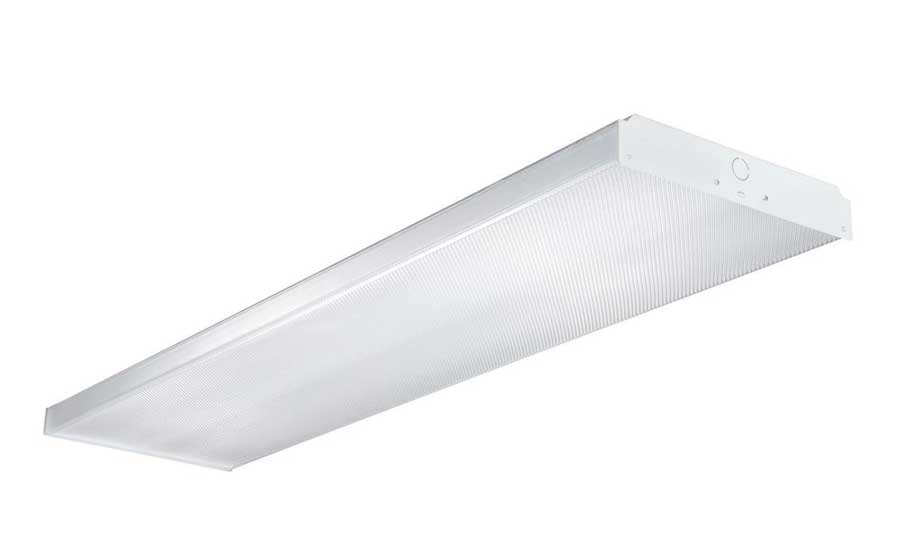
Similar to:
Shop lights, light fixtures (T5, T8, T12).
Who Should Install Wraparound Lighting in Their Garage:
Most homeowners won’t see a benefit from upgrading their shop lights to wraparound lights unless they like how the lights look. In a small space (even 3-car garages are under 1000 sq. ft), shop lights will provide similarly consistent light to wraparound lights.
However, if you’re after a sleeker, more streamlined look in their garage without exposed bulbs, wraparound lights are worth a look.
Avoid Wraparound Lighting If…
- You have a 3-car garage or smaller.
Costs:
- Initial Cost: Typically, wraparound light fixtures are moderately priced, ranging from $40 to $200+, depending on size, brand, and additional features.
- Energy Efficiency: Most wraparound light fixtures use LED bulbs, which are highly energy-efficient and can lead to significant savings on electricity bills.
Final Thoughts: Wraparound lighting combines looks and functionality. They’re excellent if you want an even distribution of light across the entire garage in a package that doesn’t look like you bought your garage lights on Amazon. They’re not suitable for every garage, but some homeowners will like the blend of design and practicality.
High-Bay Lighting
Even though you might not be familiar with the name, you’re probably familiar with high-bay lighting. High-bay lighting is designed to be used in areas with an extremely high ceiling (hence the name), like warehouses or large retail locations like Costco or Walmart.
High-bay lights are a combination of area light and spotlight. Since their light has to travel farther than standard (low-bay) lighting, high-bay lights sacrifice spread for power.
That means the area directly underneath a high-bay light will be well-illuminated. However, the light intensity drops significantly as you move away from the center. This works fine in a warehouse but looks awkward in residential garages.

Similar to:
Warehouse lighting fixtures or industrial pendant lighting.
Who Should Install High-Bay Lighting in Their Garage:
Only use high-bay lighting in barns, RV garages, boat storage, or other massive garages with high ceilings (over 20′).
Avoid High-Bay Lighting If…
- Your garage has a low to medium ceiling height.
Costs:
- Initial Cost: Commercial-grade high-bay lights can range from $100 to over $500 per unit.
- Energy Efficiency: High-bay lights are more expensive than most lighting types. Not only do they output stronger light at a higher wattage, but you’ll need more of them to evenly illuminate your garage.
Final Thoughts: High-bay lighting should only be used in large garages or high ceilings. The majority of homeowners should choose a different lighting option.
Recessed Lighting
Recessed lighting, also known as “can lights” or “downlights,” is a type of fixture installed directly into a hollow opening in a ceiling. This makes it appear that the light is shining from a hole in the ceiling, concentrating the light downward as a broad floodlight or narrow spotlight.
Recessed lighting is commonly found throughout the home, making it very inexpensive to install, upgrade, or replace. When we were building our house, I had the contractor install recessed lighting in my garage, costing around $200 in total.
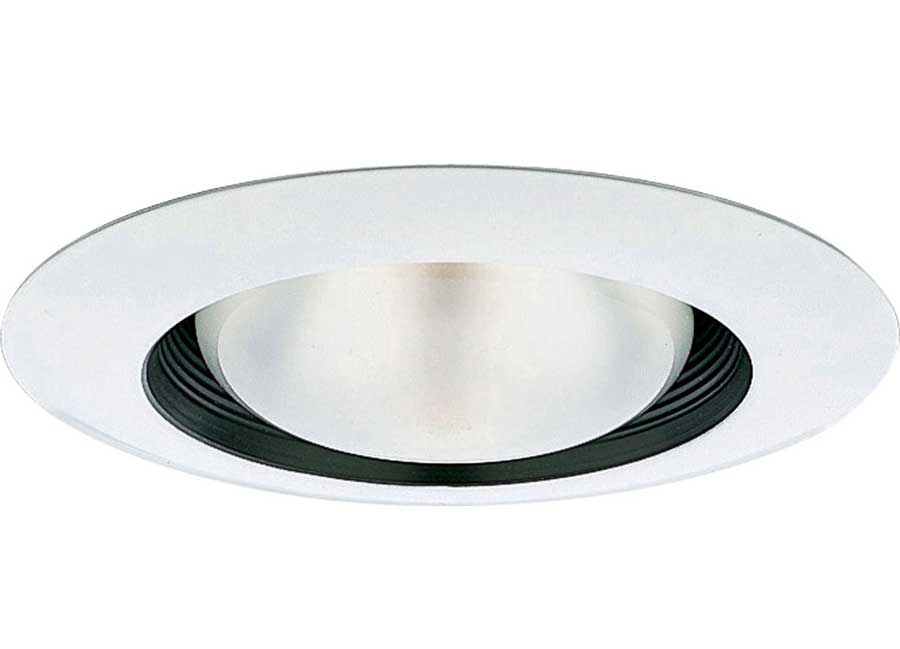
Similar to:
Pot lights, in-ceiling lights, track lighting.
Who Should Install Recessed Lighting in Their Garage:
Recessed lighting is excellent for individuals who want a clean, modern-looking garage without protruding fixtures. They’re also great for providing focused illumination in specific areas, such as highlighting your favorite car or seating area in your garage man cave. Because of how they’re designed, they’re perfect for garages with lower ceilings since they don’t hang down or take up any space beneath the ceiling.
Avoid Recessed Lighting If…
Recessed lighting needs to be hard-wired into your home’s electrical system. That makes installing them more expensive or time-consuming, whether you hire an outside contractor or go the DIY route. Although the cost-per-light is similar to LED shop lights, recessed lighting provides far fewer lumens for the money.
Costs:
- Initial Cost: On average, homeowners spend between $10 to $20 per recessed light fixture, not including installation costs.
- Energy Efficiency: Recessed lighting can be very energy efficient, especially with LED bulbs.
Final Thoughts:
Recessed lighting is a subtle way to make your garage look more expensive. They can provide even light across the entire room and blend into your garage ceiling when not in use. While I wouldn’t recommend using recessed lighting throughout your entire garage, they’re a great way to highlight specific areas or items.
Hexagon Lighting
Hexagon lighting has become extremely popular over the past few years, especially in the automotive detailing community. It comprises a series of interconnected hexagonal light panels or fixtures that can be customized and arranged in various configurations.
Essentially, it is nothing more than custom LED shop lights arranged in a geometric pattern.
They’re designed to be an eye-catching display that still provides good illumination in your garage.

Similar to:
Shop lights, decorative lighting, and connectable LED light strips.
Who Should Install Hexagon Lighting in Their Garage:
Hexagon lighting is perfect for homeowners or garage enthusiasts who want an “oh, that’s cool!” reaction whenever they show their garage to their friends.
It’s also good for enthusiasts who use their garage for multiple purposes, like a workshop by day and a recreational area by evening. Because of its modular design, it can be configured to different shapes and patterns…not just hexagons.
Avoid Hexagon Lighting If…
Hexagon garage lighting is as much about ‘show’ as it is about function. It probably won’t appeal to homeowners who simply want a powerful or efficient lighting solution.
Also, these may not be the best choice if you have a heavily cluttered garage with limited wall space.
Costs:
- Initial Cost: Hexagon lighting tends to be pricier than basic garage lighting fixtures due to its design and modularity. Expect to pay about $400 for a one-car garage hexagon lighting kit.
- Energy Efficiency: Since they use LED lights, hexagon lights will have similar energy efficiency to LED shop lights or wraparound lights.
Final Thoughts: Hexagon lighting isn’t my personal style, but there’s no denying that it makes an impression. If you’re going after a modern, attention-grabbing garage transformation, then hexagon lighting is worth the investment.
Wall Lighting
Instead of (or in addition to) mounting lights on your garage ceiling, wall lighting adds tube or shop lights to your garage walls.
They’re perfect for illuminating the sides of vehicles. Like their ceiling-mounted counterparts, wall lighting will cast an even glow over the entire area.
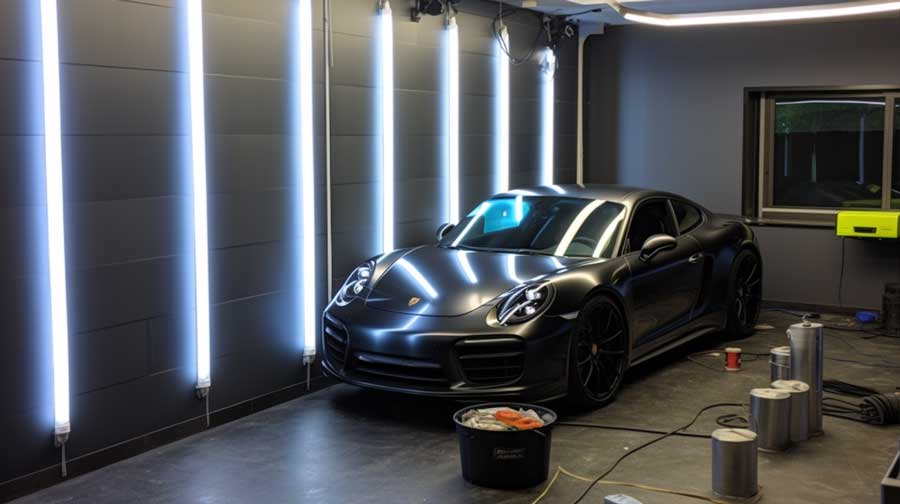
Similar to: Shop lights and sconce lighting.
Who Should Install Wall Lighting in Their Garage:
Garage wall lights are a must-have for automotive detailers, painters, or mechanics who need additional light on the sides of their vehicles.
Additionally, you can combine them with overhead or hexagon lighting to create a multi-layered lighting effect.
Avoid Wall Lighting If…
Most homeowners won’t need wall lighting in their garages. Although it adds a “cool factor” and additional lighting for specific areas, you sacrifice storage from shelving, cabinets, or other installations that might obstruct the light. Similarly, wall lighting is overkill for smaller garages that only require central overhead lighting.
Costs:
- Initial Cost: Wall-mounted LED lights cost the same as LED shop lights: as low as $20-$40. Higher-end models can go up to $100 or more.
- Energy Efficiency: LED wall lights consume significantly less power than traditional incandescent or fluorescent garage lights, leading to lower electricity bills over time.
Final Thoughts: Wall lighting might not replace the primary light source in your garage, but it can provide targeted light for specific circumstances. If you do a lot of work on the sides of vehicles (paint or detailing, for example), then wall lights are worth considering.
Garage Door Lights
When you open your garage door in most homes, it blocks your lighting fixtures. Often, homeowners have to choose between being able to see or working with the garage door open.
These LED lights mounted on the inside of your garage door were developed by LIINC to solve that problem.
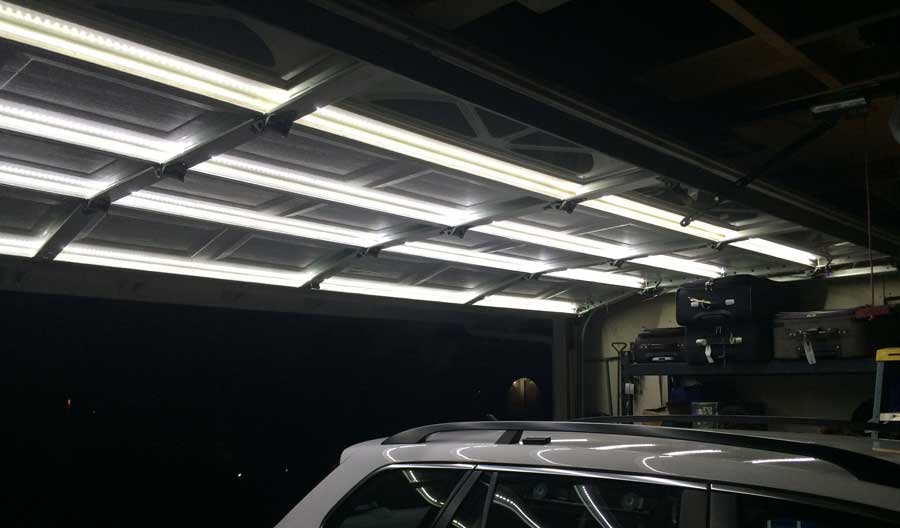
Similar to:
Shop lights, LED strip lights.
Who Should Install Garage Door Lights in Their Garage:
If you enjoy working in your garage with the door open but struggle with getting adequate lighting, these garage door lights are perfect. They’re not a replacement for other types of garage lighting, but they add additional flexibility to let you use your garage how you want to.
Avoid Garage Door Lights If…
You have an older garage door or opener. The lights add additional weight, which may cause issues over time. Alternatively, homeowners who don’t enjoy working with the door open at night in their garages will find less value from this product.
Costs:
- Initial Cost: The official version costs around $300, but you can save money by creating your own version with LED strips or tube lights.
- Energy Efficiency: Similar to LED tube lights or strip lights.
Final Thoughts:
I only recommend garage door LEDs for a few niche use cases. If you do a lot of detail-oriented work with your garage door closed and already have wall lighting, this is a great way to complete the look. In most cases, however, garage door lighting is unnecessary, and better solutions exist.
Under-Cabinet Lighting
Under-cabinet lighting refers to fixtures installed directly beneath a garage’s cabinets, shelves, or other overhead storage. These fixtures directly illuminate the workspaces or countertops below, ensuring clarity and visibility without casting shadows. They’re often used to accentuate tools, workbenches, or areas requiring focused lighting.

Similar to:
Task lighting, puck lights.
Who Should Install Under-Cabinet Lighting in Their Garage:
Anyone who owns garage cabinets installed over a workbench. Under-cabinet lighting is about as close to a slam-dunk garage lighting solution as possible.
Avoid Under-Cabinet Lighting If…
If you don’t have cabinets mounted over a workbench or detailed project area, there’s no need for under-cabinet lighting. Also, this type of lighting might be excessive if your garage has limited wall or cabinet space.
Costs:
- Initial Cost: Under-cabinet lights can range from $5 to $20 per fixture, depending on the quality and brand.
- Energy Efficiency: Because of their small size and limited use, under-cabinet LED lights are incredibly energy-efficient.
Final Thoughts: Under-cabinet lighting provides targeted lighting perfect for detail-oriented work. While they may not be suitable for every garage setup, they’re an excellent choice for those seeking focused lighting without a major installation project.
Strip Lights
Strip lights, often referred to as LED strip lights or tape lights, are flexible, adhesive-backed strips of LEDs. They can be cut to size, are easy to install, and are often used for both ambient and task lighting.
Similar to: Rope lights, under-cabinet lighting, and LED light channels.
Who Should Install Strip Lights in Their Garage:
Strip lights are best used as accent lighting or inexpensive under-cabinet lighting. They’re perfect for areas that may be hard to illuminate with traditional light fixtures, such as workbenches, shelving, or under cabinets.
Avoid Strip Lights If…
Strip lights aren’t strong enough to replace your primary garage lighting solution. Even a single-bulb garage door opener has more lumens of lighting power than your average LED strip light.
Additionally, if you’re not comfortable with DIY installation, you might find the process of measuring, cutting, and placing these lights challenging.
Costs:
- Initial Cost: Depending on the brand and quality, strip lights can range from $10 to $30 or more for a standard reel (typically 16.4 feet or 5 meters).
- Energy Efficiency: LED strip lights are generally energy efficient.
Final Thoughts: Strip lights are excellent as accent lights. Because they’re so thin, they can easily be placed behind cabinets or even other light fixtures to add a splash of color. Just don’t expect to use them as your only garage lights.
Emergency Lighting
Emergency lighting is designed to automatically turn on when the power to the primary lighting source is cut, such as during a power outage. These lights are typically battery-operated or have a backup power source to ensure safety when the main lights go off unexpectedly.
Similar to:
Exit signs with integrated lighting or backup lighting in commercial buildings.
Who Should Install Emergency Lighting in Their Garage:
Emergency lighting is required in commercial buildings but not necessarily in homes. However, homeowners who want to ensure safety during power outages should consider emergency lighting in their garages.
Avoid Emergency Lighting If…
You have a generator that automatically kicks in during power outages or has ample natural light from windows or skylights.
Costs:
- Initial Cost: Emergency lights can range from $20 for basic models to $200 or more for advanced systems with longer battery life and brighter illumination.
- Energy Efficiency: Since emergency lights are not used frequently, their energy consumption is generally low.
Final Thoughts:
Installing emergency lighting in your garage is a great way to improve your garage’s overall safety. Even if used infrequently, they’ll help provide additional peace of mind during unexpected power failures.
Types of Lighting
The right type of lighting can make all the difference to your garage transformation. The kind of lighting you choose will play a pivotal role, especially if you’re converting your garage to a workshop, gym, or extended living space.
Let’s shed some light on the options available. (pun intended)
LED (Light-Emitting Diode)
LED lights are the most common type of garage lights, and for good reason. These lights eliminate the need for a filament by passing an electric current through a semiconductor.
LEDs are highly energy-efficient, which helps the environment and your utility bill. They’re incredibly long-lasting, averaging up to 50,000 hours of light.
However, LED lights have a higher initial cost than other bulb types. Plus, there can be occasional compatibility issues with specific dimmers and fixtures.
Fluorescent
Older garage lighting fixtures typically use fluorescent lights. They create consistent, even illumination using a combination of mercury vapor and phosphor coating.
Typically, fluorescent garage lights will last longer than standard incandescent lights.
However, the UV radiation and slight flicker from fluorescents might be unsettling for some. They can also be temperamental in cold or humid conditions.
CFL (Compact Fluorescent Light)
As the name suggests, CFL bulbs are the more compact cousin of the fluorescent light. They come in a more convenient design that fits standard light sockets.
CFLs are energy efficient, consuming about 75% less power than incandescents for similar brightness levels, and last for about 8,000 hours, on average. However, they are less efficient than LED lights and need a moment or two to warm up and reach optimal brightness.
Incandescent
The classic bulb operates on a simple premise: electricity heats a filament until it glows. Incandescents are known for their soft, warm light and are inexpensive to purchase (if you can still find them).
Because of their simple design, they offer a lot of flexibility to dim or brighten them. However, they are the least energy-efficient lighting option, with most of their energy being converted to heat rather than light. They also have a relatively short lifespan and are extremely fragile.
Halogen
Halogens are the next evolution of incandescent lights. Adding halogen gas increases their brightness, making them about 30% more efficient than incandescent bulbs. However, they still fall short of LEDs or fluorescents in terms of energy efficiency.
Life expectancy is longer than traditional bulbs, and they’re known to produce a crisp, clear light. However, they can get extremely hot, so caution is advised. They also are pricier and can be challenging to find.
How to Shop for Garage Lighting: Important Features
Now that you know what type of garage lighting you want for your dream garage, here are some additional things to consider. Purchasing garage lighting isn’t as simple as simply knowing the type of fixture or bulb. While design and style are important, the following features play a critical role in your garage lighting solution.
Lumens (Brightness)
Figuring out how bright a light was used to be easy. More wattage = a brighter light bulb.
That was before LED lights became popular. Although manufacturers still advertise wattage, that only refers to how much power the light bulb uses.
Lumens is now the metric to determine how much light a source emits, essentially its brightness.
The Illuminating Engineering Society (IES) guidelines recommend a minimum of 50 lumens per square foot of space. This means an average one-car garage needs approximately 12,800 lumens, while a two-car garage requires about 20,800 lumens.
A simple table to estimate lumens based on garage size might look like this:
| Garage Size | Average Size | Lumens Required |
| 1 Car Garage | 256 sq. ft. | 12,800 Lm |
| 1.5 Car Garage | 364 sq. ft. | 18,200 Lm |
| 2 Car Garage | 416 sq. ft. | 20,800 Lm |
| 2.5 Car Garage | 452 sq. ft. | 22,600 Lm |
| 3 Car Garage | 588 sq. ft. | 29,400 Lm |
| 4 Car Garage | 760 sq. ft. | 38,000 Lm |
| 5 Car Garage | 920 sq. ft. | 46,000 Lm |
| 6 Car Garage | 1,176 sq. ft. | 58,800 Lm |
My article here shows you more information about how many lumens you need for garage lighting.
Color Temperature (warm vs. cool)
You’ve probably noticed that some lights look yellowish while others appear white or blue. This has to do with the light’s color temperature.
Color temperature is measured in kelvins (K). Lower values indicate warmer (yellow) light, while a higher value means a cooler (blue) light. Warm lights offer a relaxing aura, whereas cool lights are bright and more suitable for task-focused activities.

- LEDs can vary from 2200K to 6500K.
- CFLs usually range from 2700K to 5000K.
- Incandescents hover between 2700K and 3000K.
- Halogens are often between 3000K and 4000K.
Generally, a color temperature of 4000K to 5000K is recommended for general garage lighting. However, this can vary depending on how you use your garage.
My article here provides specific color temperature recommendations for different garage uses.
CRI (Color Rendering Index)
Have you ever noticed that some colors look…off?
Imagine you’re holding a ripe, juicy strawberry. Under a natural light source, such as the sun, the strawberry looks bright red and glossy, and you can pick out every mouth-watering detail.
But if you look at the same strawberry under a different light source, it suddenly looks dull and faded, with a pinkish or orange hue. You can’t tell if the strawberry is ripe and doesn’t look appetizing.

The difference between these two scenarios is the light source’s Color Render Index (CRI).
The sun has a CRI of 100, which means it shows the true colors of objects as they are. The second light in our example has a lower CRI, which distorts the object’s colors, making it look unnatural.
The lower the CRI, the worse the color quality.
CRI is crucial because it affects how we perceive and enjoy the things around us. That’s why CRI is essential, even for garage lighting.
High CRI lighting can improve the look of a car’s paint, a garage’s appearance, or other projects by making the colors more accurate, vivid, and realistic. It can also enhance the contrast and clarity of the details and textures of the objects.
Generally, look for garage lighting with a CRI of 90 or higher to get the most accurate color representation.
IP Rating (Ingress Protection Rating)
A light’s IP rating measures how well it is protected from dust and water. It consists of two digits. The first digit indicates protection against solid objects like dust or dirt. The second digit indicates the level of protection against liquid ingress, such as water or moisture.
Garages that are regularly exposed to dust, dirt, debris, and water should have lights with a high IP rating. These lights can better resist these elements and last longer without compromising the quality of the light.
However, you may need different IP ratings depending on the location and use of your garage.
For example, if the garage is attached to the house and has no direct exposure to rain or snow, a light with an IP rating of at least 44 may be sufficient. However, detached garages with direct exposure to rain or snow may need a light with an IP rating of at least 65.
Vapor Proof lights are garage lights with an IP rating of IP65, IP66, or IP67.
Wrapping It Up
So, what’s the bottom line when shopping for garage lighting?
While every garage is different, most homeowners would be best served with LED shop lights with:
- 5000K color temperature for a cool white light
- A total lumens of 12,000 for a single-car garage or 20,000 for a 2-car garage
- CRI of 85+
Obviously, there are some cases where you should choose different garage lights, but this should work great for most homeowners.
